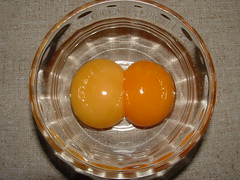Just a reminder.
The egg on the right came from a happier, healthier chicken. It's richer in minerals because it had a larger diversity of healthy food: more nourishing greens and wholesome bugs in it's diet!
Grass-fed/pastured hens are raised on pasture, as opposed to being kept in confinement and fed primarily grains. Eggs from pastured hens contain up to 20 times more healthy omega-3 fatty acids than those their less fortunate cousins, factory hens.
Pastured hens' diets are naturally complemented with bugs, earthworms, and other such critters that give their eggs a huge nutritious oomph. Although not necessarilly organic, pastured hens are usually much healthier and happier than their space-restricted and antibiotic-pumped industrial cousins.
Pasturing is the traditional method of raising egg-laying hens and other poultry. It is ecologically sustainable, humane, and produces the tastiest, most nutritious eggs.
Pastured eggs also have 10 percent less fat, 40 percent more vitamin A, and 34 percent less cholesterol than eggs obtained from factory farms. - LocalHarvest
The egg on the left is the egg many of us are used to seeing. It came from a battery or conventionally-raised chicken who probably only ate soy and/or corn and/or unknown waste products.
The same for milk -- being slightly yellowish when higher in fat and pastured (Jersey milk) -- or pasture butter being almost orange due to the amount of grazing the cows are allowed.
Today I took a trip to the World Dairy Expo. I did get to see Best Udders in Show -- or something similar. But I did not learn anything about actual milk or cheese or DAIRY! I learned about big machines, cow supplements and NEW feed (reminded me of commercials for new junk food fads like Dunkeroos but for cows).
Think about it -- have you ever seen a commercial for an apple or broccoli? Do I have a point?
Anyway, things you eat, hopefully ate well too -- which excludes any foodstuffs that have their own commercial.
NEW Suggested Reading (on GMOs):
Last winter, well-known plant pathologist and retired Purdue University professor Don Huber sent a letter to Tom Vilsack, U.S. Agriculture Secretary. In this letter he states, “A team... [has] recently brought to my attention the discovery of an electron microscopic pathogen that appears to significantly impact the health of plants, animals and probably humans.
Based on a review of this data, it is widespread, very serious, and is in much higher concentrations in Roundup Ready (RR) soybeans and corn, suggesting a link to the RR gene or more likely the presence of Roundup. This organism appears new to science!”



No comments:
Post a Comment